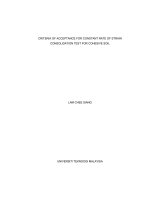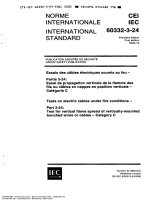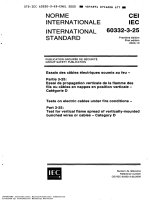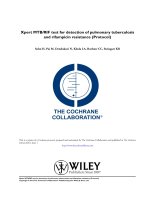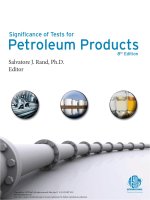ASTM D3-18 Method of Test for Toughness of Rock
Bạn đang xem bản rút gọn của tài liệu. Xem và tải ngay bản đầy đủ của tài liệu tại đây (564.04 KB, 2 trang )
AMERICAN SOCIETY FOR TESTING MATERIALS
1916 RACE .ST., PHILADELPHIA 3, PA.
Reprinted from C< pyrighted Book of ASTM Standards~ P~rt •·
Standard Method of Test for
TOUGHNESS OF ROCK1
ASTM Designation: D 3 - 18
AnOPTED1 1908; REVISED, 1918.
Reapproved in 1968 Without Change.
This Standard of the American Society for Testing Materials is issued under
the fixed designation D 3; the final number indicates the year of original
adoption as stanrlard or, in the case of revision, the year of last revision.
NoTE.--This method was editorially revised and rear-
ranged in 1939.
Scope so as to fall freely between suitable
1 This method of test covers the pro- guides.
cedure for determining the toughness of
rock. (c) A plunger made of hardened steel
Toughness and weighing 1 kg, arranged to slide
2. Toughness, as applied to rock, is freely in a vertical direction in a sleeve,
the resistance offered to fracture under
impact, expressed as the final height of the lower end of the plunger being
blow required of a standard hammer to
cause fracture of a cylindrical test spherical in shape with a radius of 1 em.
specimen of given dimensions.
(d) Means for raising the hammer
Apparatus
and for dropping it upon the plunger
3. Any form of impact machine which
will comply with the following essentials from any specified height from 1 to not
may be used in making the test:
less than 75 em, and means for deter-
(a) A cast-iron anvil weighing not
less than SO kg, firmly fixed upon a mining the height of fall within approxi-
solid foundation.
mately 1 nim. ·
(b) A hammer weighing 2 kg, arranged
(e) Means for holding the cylindrical
l Under the etandMdiution procedure of the
Society, this method is under the jurisdiction of test specimen securely on the anvil with-
) the ABTM Committee D-.4 on Road and Paving
Materials. out rigid lateral support, and under the
plunger in such a way that the center of
its upper surface shall, throughout the
test, be tangent to the spherical end of
the plunger at _its lowest po~t.
Sampling
4. Quarry samples of rock from which
test specimens are to be prepared shall
measure at least 6 in. on a side and at
564
13-15
TEST FO:& ToUGHNESS OJ!' ROCK (p 3 - 18) 565
least 4 in. in thickness, and when possible the cylhders may be sawed by means
shall have the plane of structural weak- of a bafd or diamond saw,3 or in any
ness of the rock plainly marked thereon. other W'i..Y which will not induce incipient
Samples should be taken from freshly fracture, . but shall not be chipped or
quarried material, and only from pieces broken off with a hammer. Mter sawing,
which show no evidences of incipient the ends of the specimens shall be ground
fracture due to blasting or other causes. plane with water and carborundum or
The samples should preferably be split emery on a cast-iron lap until the cyl-
from large pieces by the use of plugs and inders are 25 mm in height.
feathers and not by sledging. Com-
mercial stone-block samples from wpich Procedure
test specimens are to be prepared shall
measure at least 3 in. on each edge. 7. The test shall consist of a 1-cm fall
of the hammer for the first blow, a 2-cm
Test Specimens fall for the second blow, and an increase
of 1-cm fall for each succeeding blow
5. Specimens for test shall be cylinders until failure of the test specimen occurs.
25 mm in height and from 24 to 25 mm
in diameter, prepared' as described in Report
Section 6. Three specimens shall con-
stitute a test set. The ends of the speci- 8, The height of the blow in r.enti-
men shall be plane surfaces at right meters at failure shall be reported as th~
angles to the axis of the cylinder. toughness of the test specimen. The in-
dividual and the average toughne&. of
Preparation of Test Specimens three test specimens shall be reported
when no plane of structural weaknes!'
6. One set of specimens shall be drilled is apparent. In cases where a plane of
perpendicular and another parallel to structural weakness is apparent, the in-
the plane of structural weakness of the dividual and average tcughne5s of the
rock, if such plane is apparent. If a plane three specimens in each se~ shaH b'! r~
of structural weakness is not apparent, ported and ident:.fied. Any peculiar
orie set of specimens shall be drilled at condition of a. test ~:ped.men that might
random. Specimens shall be drilled in a affect the result, such as the presence
manner that will not subject the material of seams, fissures, etc. shall be nott'd
to undue stresses and which will insure and recorded with lhe test result.
the specified dirnensions.2 The ends of
1 A satisfactory form of diamond saw ill de-
• The form of diamond drill described il! scribed in Bulletin No. ~41, U. B. Department
Bulletin No. 847, U. B. Department of Agri- of Agriculture, pp. 7-9.
culture, pp. 6-7, is recommended, and should
prove ea.tiefactory if the iru!tructione a.re strictly
followed.
13-15
